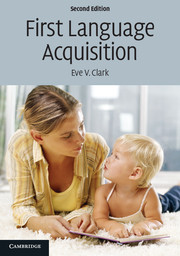Book contents
- Frontmatter
- Contents
- List of tables, boxes, and figures
- Acknowledgements
- 1 Acquiring language: Issues and questions
- Part I Getting started
- 2 In conversation with children
- 3 Starting on language: Perception
- 4 Early words
- 5 Sounds in words: Production
- 6 Words and meanings
- Part II Constructions and meanings
- Part III Using language
- Part IV Process in acquisition
- Glossary
- References
- Name index
- Subject index
5 - Sounds in words: Production
from Part I - Getting started
- Frontmatter
- Contents
- List of tables, boxes, and figures
- Acknowledgements
- 1 Acquiring language: Issues and questions
- Part I Getting started
- 2 In conversation with children
- 3 Starting on language: Perception
- 4 Early words
- 5 Sounds in words: Production
- 6 Words and meanings
- Part II Constructions and meanings
- Part III Using language
- Part IV Process in acquisition
- Glossary
- References
- Name index
- Subject index
Summary
When children start to talk early in their second year, it is often difficult to identify their first words. Their earliest attempts typically fall far short of the adult forms. Take one one-year-old's first production of the English word squirrel: ga. Upon reflection, we can trace the processes that probably led to this simplified pronunciation. First, children typically omit liquid sounds like l and r; they simplify consonant clusters, usually retaining only the stop if there is one, so in the initial cluster skw-, they drop both the glide w and the initial s-, keeping only the velar stop k; and they often voice initial stop consonants, here changing the k- into a g-. Finally, vowels in children's earliest words are typically produced with little or no narrowing of the vocal tract, here the a. In this case, we know what the target word was. But this is often not the case.
Young children are also inconsistent in how they produce the same word on different occasions. Their pronunciations vary more than adults' do from one occasion to the next, and, in their first few months of talking, they may produce multiple versions of the same word (Ingram 1974; Maekawa & Storkel 2006; Sosa & Stoel-Gammon 2006). One child, Philip, used as many as five different versions of blanket within a month. At age 1;9, he had multiple versions of 50 of the 125 words in his repertoire.
- Type
- Chapter
- Information
- First Language Acquisition , pp. 94 - 121Publisher: Cambridge University PressPrint publication year: 2009



